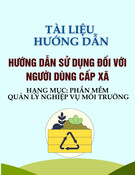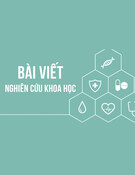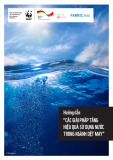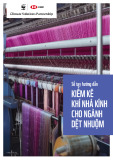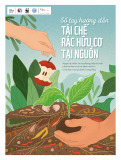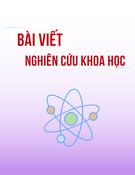
ISSN: 2615-9740
JOURNAL OF TECHNICAL EDUCATION SCIENCE
Ho Chi Minh City University of Technology and Education
Website: https://jte.edu.vn
Email: jte@hcmute.edu.vn
JTE, Volume 19, Issue 03, 2024
32
Effect of Extraction Conditions on Carotenoids from Rhodotorula Mucilaginosa
Khanh Dung Pham1* , Thi Ngoc Dung Dang1, Van Hung Tran2
1Ho Chi Minh City University of Technology and Education, Vietnam
2Hong Bang International University, Vietnam.
*Corresponding author. Email: dungpk@hcmute.edu.vn
ARTICLE INFO
ABSTRACT
Received:
28/04/2024
Carotenoids are a group of 40-carbon isoprenoids with high lipid solubility,
widely found in fruits, vegetables, etc. They have an unsaturated structure
with strong antioxidant activity that helps prevent low-density lipoprotein
oxidation and protect cells from free radicals. Currently, carotenoids are
not only synthesized from natural sources such as plants but also from
microorganisms such as bacteria, yeast, algae, etc. One more attention,
becoming an important research area, using microorganisms to produce
carotenoids has advantages over than plants because it saves costs and can
be more easily expanded to an industrial scale. Therefore, in this study, the
influence of extraction conditions such as organic acid, ultrasound time,
and solvent on the carotenoid extraction from the yeast Rhodotorula
mucilaginosa was investigated. The result showed that the process of
carotenoid extraction follows 3M citric acid combined with 30 minutes of
ultrasound for cell disruption; complete extraction process in 100% ethanol
with dry cell weight/ethanol ratio of 1/50 g/mL. The total carotenoid
content reached 548.98 ± 6.30 µg/g.
Revised:
23/05/2024
Accepted:
18/06/2024
Published:
28/06/2024
KEYWORDS
Carotenoid;
Ultrasound-assistant;
Microorganisms;
Extractions;
Rhodotorula mucilaginosa.
Doi: https://doi.org/10.54644/jte.2024.1574
Copyright © JTE. This is an open access article distributed under the terms and conditions of the Creative Commons Attribution-NonCommercial 4.0
International License which permits unrestricted use, distribution, and reproduction in any medium for non-commercial purpose, provided the original work is
properly cited.
1. Introduction
Rhodotorula mucilaginosa is capable of biosynthesizing specific carotenoids, such as β-carotene,
torulene and torularhodin in various ratios and producing β-carotene using large fractions [1].
Carotenoids are a family of natural organic pigments that play an important role in life and are found in
plants, algae, rubies, persimmon, bacteria and some photosynthetic organisms. Carotenoids are
considered color nutrients because they have many similar properties to vitamins that create yellow,
orange, and red colors in both the plant and animal kingdoms. In plants, carotenoids are found in leaves
along with chlorophyll, in flowers, fruits and vegetables. In the animal body, carotenoids are dissolved
in fat or protein compounds in the aqueous phase. Humans cannot naturally synthesize carotenoids and
depend on dietary sources of nutrients. There are currently about 850 naturally occurring carotenoids
reported up to 2018 and they are divided into two main groups: xanthophyll and carotene [2].
Compound carotenoids can continue to be found and obtained from a variety of sources. We can get
it from chemical synthetic sources (accounting for 70 ÷ 80%) and natural sources (using only 20 ÷ 30%).
In plants, carotenoids are abundant in fruits and vegetables. Typically, in carrots, the β-carotene content
reaches 87 μg/g; Gac fruit contains β-carotene content of about 101 ± 38 µg/g and lycopene content of
about 380 ± 71 µg/g; in tomatoes, the β-carotene content is 62 μg/g and the lycopene content reaches
114.4 μg/g [3], [4]. In animals, carotenoids contribute to the brilliant colors observed in the fur, skin,
white or feathers of many animals such as birds or fish,... The carotene group is abundant in fish liver,
especially mackerel liver and in the liver of animals such as chickens, ducks, pigs and in some other
species such as fish, eggs, insects, poultry, etc [5]. The carotenoid production process of microorganisms
takes place in cells, so to recover carotenoids from microorganisms, cells need to be broken to create
conditions for the solvent to penetrate and dissolve carotenoids. Most traditional extraction methods
have used processes based on volatile organic solvents as solubilizers. Besides, in recent years, many
researchers have searched for new and effective replacement techniques, especially: (a) replacing
volatile organic solvents with greener, bioavailable solvents. compatible and less toxic waste, such as
supercritical waste, biological media or ionic waste and (b) reduce the amount of solvent media required

ISSN: 2615-9740
JOURNAL OF TECHNICAL EDUCATION SCIENCE
Ho Chi Minh City University of Technology and Education
Website: https://jte.edu.vn
Email: jte@hcmute.edu.vn
JTE, Volume 19, Issue 03, 2024
33
through the combination process of chemical extraction with new physical processes (such as extraction
with the sophistication of microwaves and ultrasound) or biological straining processes (such as
extraction with enzyme activity) [6].
Carotenoids are tetraterpene compounds (C40H56) formed by the combination of eight isoprene units
[7]. Carotenoids have a straight chain structure, eight 5-carbon isoprenoid units linked together, and
through the center, there is an alternation of double and single bonds. Some carotenoids in structure
contain six-ring edges or contain more oxygen such as alcohol, aldehyde, ketone, carboxylic, and epoxy
radicals. From this basic structure, most other carotenoids can be generated through hydrogenation,
cyclization, oxidation, or any logical outcome of these processes [5], [8].
The process of extracting carotenoids is often performed using a chromatography column [9]–[14].
Because carotenoid is nonpolar, it is cleaved using polar media such as hexane, acetone, and petroleum
ether and measures optimal density (OD) at 400-600 nm [15]. For algae, carotenoid extraction could be
performed by using a large amount of cooking oil and performing high-pressure homogenization, which
enhances the efficiency of carotenoid extraction from algae. Other extraction methods have also been
used such as supercritical CO2 extraction, pressurized liquids extraction and different solvent extraction
[16]–[18]
In this study, we investigated some conditions affecting the extraction of total carotenoids from R.
mucilaginosa using environmentally friendly chemicals: cell disruption conditions with organic acids
combined with ultrasound-assistant method, using ethanol and petroleum ether solvents to replace
acetone in the process of extracting total carotenoids to obtain a benign product, easy to apply in food.
2. Materials and Methods
2.1. Strains and culture conditions
The Rhodotorula mucilaginosa ATCC® 66034™ was bought from a Microbiologics (U.S.A). 2%
glucose, 1% yeast extract, 1% peptone, and 2% agar were placed on YPD agar plates (Yeast Peptone D-
Glucose), R. mucilaginosa was cultivated for three days at 30°C before being stored at 4°C. For pre-
cultivation, the YPD with 2% D-glucose medium was utilized, and for carotenoid accumulation, the
YPD with 10% D-glucose was used. After being pre-cultivated for 24 hours in YPD 2% D-glucose
medium with an initial optical density of 660 nm = 0.1, they were cultured in YPD 10% D-glucose
medium for carotenoid production as reported of Naoto Urano with some modified [19].
2.2. Cultivation and dry cell
Cells from 5 days of cultivation were washed by distilled water twice time and centrifugation at 5000
rpm in 15 min. The dry cell was obtained by Freezing dry by a DC401Freeze Dryer (Yamto, Japan).
2.3. Cell disruption
The experiments concerning acid and ultrasound-assisted cell disruption were performed following
the procedures described by Hui NI [20] with modifications using an ultrasonic-assisted following
Letícia Urnau [21]. 1.5 mL of acid 2.5 M was added into a 15 mL falcon containing 0.1 gram dry cell.
Vortex at 1000 rpm for 5 minutes, then let the ultrasound in the Elmasonic S100H (Germany) for 30
min at 30 °C. Then, centrifugating at 3500 rpm for 20 minutes and remove the acid.
2.4. Extraction of carotenoids from R. mucilaginosa
After cell disruption, 5 mL of acetone solvent was added to the falcon, shake well with a vortex
machine at 1000 rpm for 5 minutes. Finally, centrifuge at 3500 rpm for 20 min to remove cell debris to
collect the solvent containing carotenoids.[20]
For investigating of cell disruption condition and solvent extracted condition, type of acid (non-acid,
citric, lactic, acetic), concentration of acid (1.5; 2.0; 2.5; 3.0; 3.5 M), dry cell weight/acid ratio
(1/10;1/15; 1/20 w/v), ultrasound-assisted time (0, 10, 20, 30, 40, 50 min), type of solvent (acetone,
ethanol, petroleum, ethanol: petroleum = 1:1) and dry cell weight/solvent (1/40; 1/50; 1//60; 1/70 w/v)
were researched.
2.5. Determination of total carotenoid content

ISSN: 2615-9740
JOURNAL OF TECHNICAL EDUCATION SCIENCE
Ho Chi Minh City University of Technology and Education
Website: https://jte.edu.vn
Email: jte@hcmute.edu.vn
JTE, Volume 19, Issue 03, 2024
34
The absorbances were read on Hitachi UH-5300 UV-VIS spectrophotometer.
Considering solely these major abundant carotenoids and exchanging α-carotene for a broader
carotenoid spectrum, absorption coefficient for β -carotenoid in the acetone solvent A1%1cm = 2500
(represents the extinction at a certain wavelength and in a certain solvent of concentration 1%, in a
cuvette with a diameter of 1 cm, at 454nm) and in the ethanol solvent A1%1cm = 2620, in the petroleum
ether solvent A1%1cm = 2592 [8], [15], [22]. The formula for total carotenoid content (TCC) as:
𝑻𝑪𝑪 (µg/g) = A ∗ V ∗ 1000 ∗1000
𝐴1𝑐𝑚
1% ∗ 𝑃 ∗ 100
TCC: total carotenoid content, µg/g
A1%1cm represents the extinction at a certain wavelength and in a certain solvent of
concentration 1%, in a cuvette with a diameter of 1 cm.
A: absorbance of sample at optimum absorption
V: volume of sample, mL
P: weight of dry cell, g
2.6. Statistical analysis
All experiments were replicated at least three times. The student’s t-test was used to determine the
statistically significant differences (p ≤ 0.05).
3. Results and Discussion
3.1. Effect of organic acids on carotenoid extraction
To investigate the effects of organic acid on cell disruption, citric acid, lactic acid, and acetic acid
in 2.5 M concentration were used and no acid was used as the control sample. The color of carotenoid
samples with various organic acids showed different colors, ranging from light pink to pink as in Figure
1A.
Figure 1. The color of carotenoid production of R. mucilaginosa in the different extraction condition. A. Type of
organic acid in 2.5 M; B. Citric acid concentration; C. Dry cell/citric acid ratio (w/v); D. Ultrasound time (min)
From citric acid to lactic acid, and acetic acid, the color of carotenoid samples was gradually getting
lighter, and the citric acid has given the darkest color. This result is consistent with TCC of various acids
in Figure 2A. Results in Figure 2A showed that using the acid led to receiving higher TCC when
comparing acid and no-acid sample. It was suggested that the acid disruption was effective on the cell
disruption. Among using acids, citric acid resulted in the highest TCC that was approximately 3 times
higher than the TCC of the control sample (247.33 ± 5.03 μg/g compared to 70.67 ± 8.38 μg/ g).
Following was lactic acid then acetic acid with 177.33 ± 3.40 μg/g, 110.67 ± 8.38 μg/g of TCC,
respectively.
The extraction efficiency is not the same in the different acids, it might depend on the acidity of these
acids. Acids with higher acidity will be more effective in breaking down yeast cells and have a higher
ability to extract carotenoids and vice versa. The acidity of an acid could be measured and compared by

ISSN: 2615-9740
JOURNAL OF TECHNICAL EDUCATION SCIENCE
Ho Chi Minh City University of Technology and Education
Website: https://jte.edu.vn
Email: jte@hcmute.edu.vn
JTE, Volume 19, Issue 03, 2024
35
the value of the acid dissociation constant pKa. The lower the acid dissociation constant, the stronger
the bond between the proton and the acid molecule, so the higher the acidity. Citric acid has the highest
acidity with a pKa constant of 3.15 in the first carboxyl group and 4.77 in the second carboxyl group.
Meanwhile, lactic acid has a lower acidity with a pKa constant of 3.86 and ascorbic acid has the lowest
acidity with a pKa constant of 4.10. Among the organic acids commonly found in foods, citric acid is
also the acid with the lowest pKa constant [23].
Figure 2. Total carotenoid content in the different extraction condition. A. Type of organic acid in 2.5 M; B.
Citric acid concentration; C. Dry cell/acid ratio (w/v); D. Ultrasound time (min); E. Type of solvent; F. Solid-
solvent ratio. Different letters indicate statistically significant differences (P≤0.05).
3.2. Effect of acid concentration on carotenoid extraction
Citric acid with different concentrations ranges from 1.5 M to 3.5 M were studied the acid
concentration on the carotenoid extraction. The color of carotenoid sample is shown in Figure 1B. The
color of carotenoid sample became darker when enhancing the acid concentration from 1.5 M to 3 M.
At 3.5 M citric acid concentration, the color of carotenoid sample was lighter than that in the 3 M citric
acid. It meant that the carotenoid content reduced if acid concentration continued increasing.
The TCC in Figure 2B indicated the same results of carotenoid color, which is the gradually
increasing TCC when intensifying acid concentration. However, the maximum acid concentration was
only at 3 M. If continuing to rise the acid concentration to 3.5 M, the TCC tends to decrease. In 3 M of
citric acid, the TCC was 268.67 ± 2.31 μg/g, while the TCC was down 236.67 ± 11.37 μg/g in 3.5 M
citric acid. The acidity of the environment depends on the acid concentration of the environment. The
environment becomes more acidic and more efficient at dissolving cells as the concentration of acid

ISSN: 2615-9740
JOURNAL OF TECHNICAL EDUCATION SCIENCE
Ho Chi Minh City University of Technology and Education
Website: https://jte.edu.vn
Email: jte@hcmute.edu.vn
JTE, Volume 19, Issue 03, 2024
36
rises. The environment's acidity reaches its limit when the acid concentration reaches 3 M, so the
resulting β-carotene content does not change at higher concentrations and tends to decrease as the acid
concentration rises because acidic environments cause pigments to decompose [24].
3.3. Effect of dry cell/acid ratio on carotenoid extraction
The TCC of dry cell/acid ration experiment is shown in Figure 2C. When increasing the dry cell/acid
ratio, the TCC increased from 188.67±12.22 μg/g at a ratio of 1/10 g/mL to 261.33±9.57 μg/g at a ratio
of 1/15 g/mL. Due to the increased dry cell /acid ratio, the amount of acid in the medium increased,
leading to higher cell lysis efficiency and carotenoid extraction. When continuing to increase the dry
cell/acid ratio to 1/20 and 1/25 g/mL, the TCC was downed to 179.33±4.11 μg/g at the ratio 1/20 g/mL
and still 156.67±8.99 μg/g at the ratio 1/25 g/mL. The reason is because the increased volume causes
the cell density per medium volume to decrease, the ability to collide between cells during the ultrasound
process decreases, leading to unsatisfactory cell disruption during the ultrasound process. Effectively,
the resulting TCC is significantly reduced. From there, it could be encouraged that the dry cell/acid ratio
not only affects the cell breakdown process but also has a certain influence on other factors related to
the carotenoid extraction process. It is necessary to determine the optimal ratio to achieve high efficiency
and influence other factors.
3.4. Effect of ultrasound time on carotenoid extraction
To investigate the effect of ultrasound time on the efficiency of carotenoid extraction from yeast,
ultrasound in a time range from 0 to 50 min with jumps of 10 min were carried out. The color of
carotenoid sample is shown in Figure 1D. The TCC is shown in Figure 2D.
From these results, it could be suggested that ultrasound has a great impact on the efficiency of
carotenoid extraction. The time of using ultrasound also greatly affects the TCC. During the first 10 min
of ultrasound, the TCC was 108.67± 13.30 μg/g and no significant difference when compared with no
ultrasound-assistant. However, after 20 min ultrasound, the TCC was 194.67 ±11.12 μg/g that
approximately 2 times higher than no ultrasound-assistant. The highest amount of TCC was recorded
with 30 min of sonication, with the resulting being 269.33 ± 56.80 μg/g. When the ultrasonic treatment
was settled longer than 30 minutes, the amount of TCC was decreased. At 40 min and 50 min ultrasound
time, the TCC obtained only 172.00 ± 4.9 μg/g and 155.33 ± 12.26 μg/g, respectively.
According to Ye et al, ultrasound effectively disrupts the cell disruption process because it has the
ability to create a turbulent flow within the liquid. During this process, particles in the liquid collide
with each other at high speed [25]. Similarly, a study on ultrasonic also showed convective effects
created by the continuous production and destruction of bubbles, further increasing the fluctuations of
liquid caused by the transmission of ultrasonic [26]. Thus, ultrasound plays an important role in breaking
cells, creating conditions for solvents to penetrate and dissolve carotenoids. In the study of Ye et al.,
ultrasound time is also a parameter that affects extraction yield because of the ability to generate heat or
create free radicals in the solvent [25].
In our experiment, the temperature of the sample during the ultrasound process was controlled at
room temperature. Thus, the carotenoid content gradually decreases when we perform ultrasound for
more than 30 minutes. The reason might be that under ultrasound conditions, the solvent has the ability
to create free radicals. If this happens, the carotenoid structures will be destroyed in two different ways:
first, the double bonds in the carotenoid will be oxygenated to form -C=O, and second, the chains of the
carotenoid molecule will be broken down or polymerized.
3.5. Effect of solvents on carotenoid extraction
Aim to replace acetone solvent by green solvents, other solvents including ethanol, petroleum ether
and ethanol: petroleum ratio 1:1 were studied for their effects on carotenoid extraction. In which, the
acetone solvent sample is used as a control sample. Ethanol and petroleum ether were used to replace
acetone in the extraction to obtain friendly products and more easily apply to the food. The color of
carotenoid sample with various solvents is shown in Figure 3 and TCC is shown in Figure 2E.

![Đề cương Công nghệ Polyme và Compozit [mới nhất]](https://cdn.tailieu.vn/images/document/thumbnail/2025/20250901/hungngao2711/135x160/24771756869342.jpg)
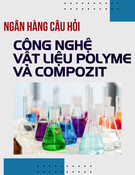
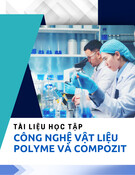
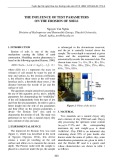



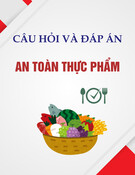


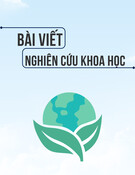


![Bài giảng Chế biến khoáng sản vô cơ [Mới nhất]](https://cdn.tailieu.vn/images/document/thumbnail/2025/20251025/thanhvan173002/135x160/21521761538638.jpg)
